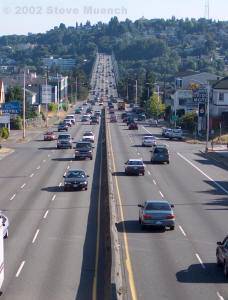Arterials & Highways
Arterials roads provide service to large areas and usually connect with other arterial roads or highways. They are generally characterized by high traffic volume, heavy loading and widely varying speeds. Highways are roads that provide primary transportation routes between geographic locations such as cities and towns. They are characterized by varying traffic volume, heavy loading and widely varying speeds.

Figure 1: Aurora Avenue

Figure 2: US 97 South of Blewett Pass
Assumed Traffic
Due to its extremely varied nature, it is not possible to provide a simple generalization of arterial and highway traffic. Some highways, such as I-5 in Tacoma may experience as many as 100 million ESALs during their design life, while others may experience less than 1 million ESALs.
Design Considerations
Arterials and highways require special design considerations. These pavements should only be designed using an approved structural design procedure, well-reasoned mix type selection and proper mix design.
Construction Considerations
Each arterial and highway construction project requires project-specific considerations.
Recommended References
- American Association of State Highway and Transportation Officials (AASHTO). (1993). AASHTO Guide for Design of Pavement Structures. American Association of State Highway and Transportation Officials. Washington, D.C. (www.aashto.org)
- The Asphalt Institute. (1999). Thickness Design – Asphalt, Manual Series No. 1. The Asphalt Institute. Lexington, KY. (www.asphaltinstitute.org)
- National Asphalt Pavement Association (NAPA). (2001). HMA Pavement Mix Type Selection Guide, Information Series 128. National Asphalt Pavement Association. Landham, MD. (www.hotmix.org)
Design Catalog



